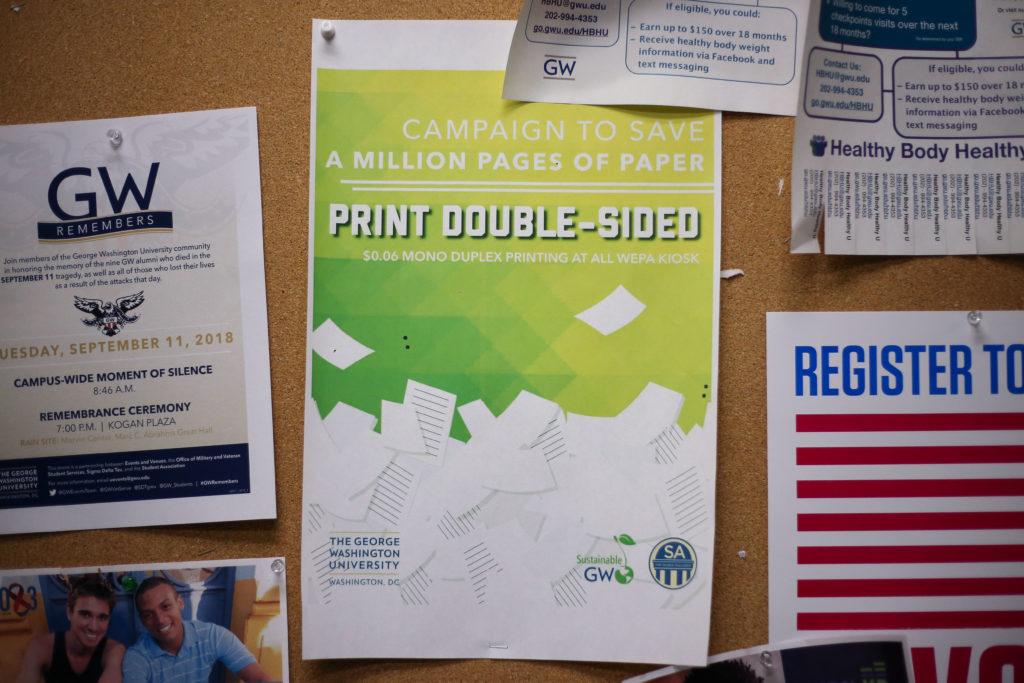At the conclusion of a nearly yearlong push to save 1 million pieces of paper by the end of the summer, Student Association leaders said they hit about 75 percent of their student savings goal.
But student leaders do not know if they hit their 1 million-page target because 40 percent of the campaign was intended to be comprised of faculty savings, and faculty never reported the number of pages they saved throughout the academic year, Logan Malik, the SA’s former vice president for undergraduate student policy who launched the campaign, said.
SA leaders said printing at on-campus WEPA kiosks decreased by more than 450,000 pages during the course of the “Save a Million” campaign, which encouraged students and faculty to limit their use of University printers by printing double-sided pages. The savings fall about 150,000 pages short of the campaign’s student savings goal, but student leaders said the project still moved the University toward lasting sustainable practices – starting with a major cut on paper usage.
“The impact of this effort is not a one-year thing, it’s not a two-year thing,” Malik said. “It’s going to be something that affects the University’s carbon footprint for years to come – 451,900 pieces of paper is no small feat.”
At the start of the campaign, Malik said he would track faculty numbers through the tool PaperCut, which the Columbian College of Arts and Sciences began using in fall 2016 to track how often and how much faculty members printed. He had said he would also contact the companies GW contracts for printing services, including Xerox, Ricoh and Canon, to obtain statistics. All of these efforts were fruitless, he said.
“Things didn’t come together as quickly as I would’ve liked, and I definitely would blame myself for that,” Malik said. “But again, we were told that we could get the numbers, and we probably still could, but it’s a question of ‘is this worthwhile?’”
University spokeswoman Maralee Csellar said that officials don’t have a tally of the total number of printed pages by all faculty because faculty printing is a “decentralized process handled by schools and departments.”
“We always encourage faculty and staff to consider sustainability efforts in their daily work, including being mindful of their printing and printing double-sided,” Csellar said in an email.
She declined to say how faculty in different schools track paper usage and if officials within schools were involved in the campaign.
Malik said the student numbers were reported through quarterly WEPA reports. At the end of the fall semester, SA leaders had reported about 163,000 saved pages – just about a quarter of the student savings goal.
But during the fourth quarter between April and June, students printed 167,000 fewer pages than the year before – more than the past six months of the campaign combined, according to a report obtained by The Hatchet.
Half a million pieces of saved paper can conserve about 54 full-grown trees, 12,800 pounds of greenhouse gases and 43,000 gallons of water, according to research from Cleveland State University.
Malik said SA leaders encouraged students to save paper by visiting classrooms to promote the project and cutting the double-sided printing cost by 1 cent.
SA President Ashley Le said that moving forward, the SA won’t continue the campaign, instead turning its attention to other projects, including a student-led sustainable food cooperative. She said student leaders will still leave up the campaign posters and promotional graphics that were plastered around campus during the campaign last year.
“The goal was to save 1 million pieces of paper, but the mission was to promote sustainable practices,” Le said.
Izzy Moody, the SA’s vice president for sustainability, said this year’s SA will “support a similar vision” of promoting sustainable practices even though it won’t continue the campaign explicitly.
“Obviously, the campaign didn’t save a million – but any number of paper saved from this campaign is a huge success and can only improve from here,” she said.
University spokesman Tim Pierce said the Office of Sustainability is “thrilled” by the campaign outcome, which it helped to advertise through the office’s website and social media outlets.
“The office supported the Student Association in their efforts to launch a campaign to provide double-sided options for Colonial Printing by helping them to scope the proposal and business case and supporting them in meetings with key decision makers,” Pierce said in an email.
Sydney Nelson, the SA’s former executive vice president, said she and former SA President Peak Sen Chua helped publicize the campaign through weekly SA newsletter blasts and social media posts. The SA also switched to printing on 100 percent recycled paper to add onto the momentum of the campaign, she said.
“When we launched this campaign, it was really ambitious – it’s a lot to say we’re going to try to save a million pieces of paper,” she said. “I think we got a lot of interest on campus in terms of student engagement and responsiveness to it.”





